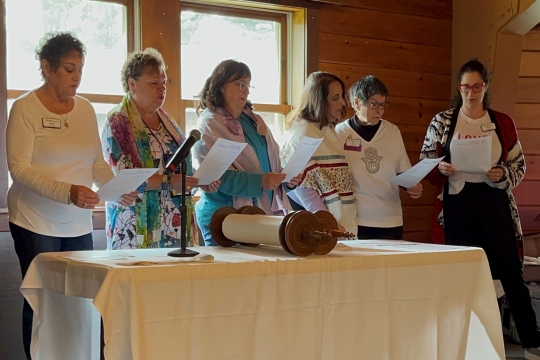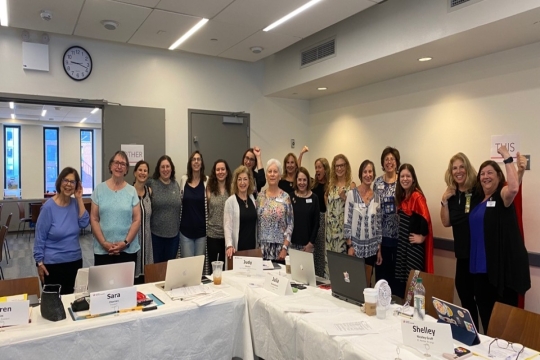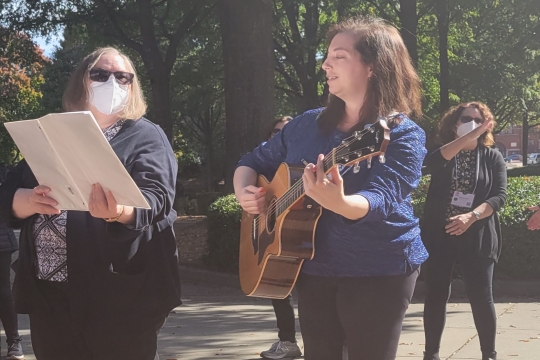by Vivian Blumstein
This week’s portion, Ki Tisa (Exodus 30:11-34:35), has several major passages, each of which deals with the relationship between God and Israel and an issue that is pivotal for both them as well as our sisterhoods and WRJ–reconciliation.
The first section of the parashah starts with instructions for the Tabernacle, with details about the census, laver, anointing oil, incense, artisans, and Shabbat observance. A lot has been written about the census and how women were not included. This is certainly an important discussion, but not one that I will focus on here.
The next section of the parashah tells the story of the Golden Calf. When the Israelites saw that Moses was staying up on Mount Sinai for a long time, they became upset and Aaron made a golden calf out of the jewelry the people gave him. The Israelites worshiped the Golden Calf and acted badly. God then accused the Israelites of being “a stiff-necked people” and wanted to destroy them. It was only due to Moses’ intervention on behalf of the Israelites that they were spared. At this point, God was so angry that it seemed that the covenant previously made with the Israelite people would be abandoned. Again, Moses interceded and God restored the covenant.
The last section deals with reconciliation–between Moses and God, between Moses and the people, and between God and the people. The building of the Golden Calf was a huge violation of the relationship between God and the people, but somehow, the relationship was maintained.
To me, this portion resonates in many ways. Through my varied experiences with WRJ, I have seen the many ways in which women of sisterhoods interact and I have also seen the interaction between sisterhoods and temples. Let’s be honest–there are no groups in which the members get along in perfect harmony. This would be nice, but I have not seen it happen.
There are women in some sisterhoods who feel that they “know it all” and are not welcoming or encouraging to others. This causes strife in the sisterhood and sometimes results in the disintegration of the sisterhood. There are also temples where the interaction between the sisterhood and the temple officers is difficult.
I think these groups would do well to learn from the interaction between God, Moses, and the Israelites. It seems to me that if the Torah tells us that reconciliation was possible, even after such a big problem, then the members of sisterhoods can learn to get along and work well together, and temples and sisterhoods can do the same.
WRJ has always tried to foster better relations–either between the women of an individual sisterhood or between sisterhoods and their temple leadership (where we have the support of the Reform Movement). If there are issues your sisterhood needs help with, please reach out to WRJ!
As members of WRJ, it is up to us to bring reconciliation–we have a bond between us that helps bring us together. Let us reach out to members of our own sisterhoods. I believe that we, as members of our sisterhoods, and, WRJ, are engaged in holy deeds. And truly, we are “stronger together”.
Vivian Blumstein is a member of the WRJ Board of Directors, WRJ Northeast District Vice President of Marketing and Communications, and Past Sisterhood President of Temple Am Echad in Lynbrook, NY.
Related Posts
Image

Parashat Yom Rishon shel Rosh HaShanah
September 14, 2023
During the High Holidays, my thoughts turn to the special blessings, prayers, and melodies that shape our journey from Selichot to Rosh HaShanah to the final shofar blast on Yom Kippur. Many of our prayers in the High Holiday liturgy are written in the plural.
Image

Cultivating a Culture of Accountability and Belonging
September 8, 2023
And, we’re off! Many of us have worked over the summer with friends and colleagues to set the calendar for the year ahead, including meetings, events, and other opportunities for gathering.
Image

My Journey from Altar-Girl to Cantorial Soloist
August 11, 2023
I was born a Goldman, and always knew I was Jewish on my dad’s side. Although my whole family was spiritual in their own way, the Jewish side of my family didn’t have warm feelings towards religion, and the only thing passed down to me was the Jewish humor I grew up in New Jersey and had an open...
